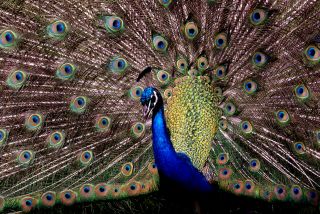Mating
Do 'Macho' Men Get All the Attention in the Dating Pool?
New research into how we really choose our partners.
Posted September 22, 2015

We know that men and women differ physiologically. Why these differences exist is less clear. One aspect of these differences that I study is the evolution of male facial shape. Males tend to have larger heads than females, with exaggerated jaw lines, thicker brows, and heavier set features. Male faces also show tremendous variation. This continuum, broadly speaking, spans highly masculine and feminine features, with some males sporting enormous lantern jaws with thick, rugged brows while others have soft, plump lips, high cheekbones, and large, neotenous eyes [1].
Many presume that these variations arose as a result of female preferences acting via sexual selection [2]. Females show nearly as much variation in their preference for facial masculinity as males do in displaying it. This is thought to reflect an evolutionary trade-off: Sexy, lumberjack types, with heavy-set features, are often thought to be genetically superior, as their larger facial features are a byproduct of testosterone. Far from being good for you, though, testosterone actually hampers the immune system—as a result, it can be considered a handicap.
In evolutionary theory, displaying handicaps and costly traits (i.e. testosterone-dependent facial features) can be a signal of underlying quality that only healthy individuals are capable of producing. The classic example is the peacock's tail, full of bright, lurid colors which can have the downside of attracting predators and making negotiating the environment quite difficult [3].
Under this logic, highly masculine males actually signal how strong a man's immune system is by basically announcing how much of a burden they are capable of shouldering while still functioning. This might sound counterintuitive but there is some evidence to suggest that high-testosterone males may have better health than others. with some studies finding that masculinity is associated with health benefits including a lower incidence of self-reported illness [4, 5].

High testosterone isn’t all positive, however, and such males are perceived as being more aggressive and, therefore, poorer long-term partners [6] who might be more likely to cheat or become violent. Neither of these traits is particularly desirable in a partner and as a result more "feminine" males, who have been exposed to less pubertal testosterone, tend to be perceived as superior parents.
In line with predictions about masculinity and genetic quality, female preferences for more masculine faces tend to align with mating opportunities that offer the greatest genetic benefit—for examples, in studies women show less of a preference for more feminine male faces during ovulation, when their chances of conception are greatest [7, 8]. Manly men, however, are preferred when women are asked to rate faces for a short-term, sexual relationship [8-11]—a one-night stand. Finally, when women have been cued to consider the risk of diseases they also tend to prefer masculine faces [12-14]. On the other hand, more feminine male faces are preferred when women in studies are primed to think of resource scarcity, [15] and by women who consider themselves to be from a lower socioeconomic background [16].

Taken together, these studies seem to suggest that women prefer more masculine men when genetic benefits are likely, and, conversely, prefer more feminine male faces when the genetic benefits are unlikely or when less aggressive, more stable partners would be more beneficial.
However, the evidence is far from conclusive.
For instance, two competing meta-analyses (large-scale statistical reviews of the results of previous studies) found conflicting support for the idea that women’s menstrual cycles influence facial preferences at all [17, 18]. Additionally, some studies have failed to find any association with preferences for healthy faces and preferences for "masculine" faces [1, 19], which undermine the idea that females select male faces based primarily on perceptions of health.
One possibility that had been neglected until recently is that female facial preferences are actually shaped by genetic influences. A number of studies have identified genetic influences that can account for as much as 50 percent of the variation in an individual’s desire for certain characteristics in potential mates [20, 21].
In a recent study published in Psychological Science, my colleagues and I investigated whether such genetic influences might underlie female preferences for masculine faces. By measuring these influences, we would also be able to compare their magnitude against the impact of the context-dependent factors suggested by the good-genes hypothesis, such as ovulatory cycle and pathogen sensitivity. To do this, we used data collected from thousands of identical and non-identical twins. Because identical twins share all of the same genes while non-identical twins share half, we can use statistical modeling to estimate genetic effects on many different traits.
We found that the combined effect of contextual factors accounted for less than 1 percent of variation in women’s preferences for facial masculinity. On the other hand, genetic effects accounted for nearly 40 percent of the variation. This means that any differences between two women’s preferences for masculine males is more likely to be due to their genes than to any of the previously proposed evolutionary contextual factors.
This doesn’t mean that contextual factors are unimportant or that genes completely determine whom we’re attracted to: The majority of variation in facial preferences (around 60 percent) was still unexplained in our study, leaving ample room for alternative explanations and other environmental influences.
What we have shown is the relative importance of genetic variation in influencing our romantic preferences, and more generally, highly complex traits. It remains unknown whether these preferences actually push us toward partners who carry these traits.
Our choice of a long-term romantic partner is one of the most important decisions we will ever make; the idea that our genes could influence this process has enormous ramifications.
The next challenge will be explaining how this genetic variation fits into the broader story of our evolution, including how it influences actual partner choice.
1. Enlow, D.H., R.E. Moyers, and W.W. Merow, Handbook of facial growth. 1982, Philadelphia: Saunders.
2. Little, A.C., B.C. Jones, and L.M. DeBruine, Facial attractiveness: evolutionary based research. Philosophical Transactions of the Royal Society B-Biological Sciences, 2011. 366(1571): p. 1638-1659.
3. Zahavi, A., Mate selection: A selection for handicap. Journal of Theoretical Biology, 1975. 53(1): p. 205-214.
4. Rhodes, G., et al., Does sexual dimorphism in human faces signal health? Proceedings of the Royal Society of London. Series B: Biological Sciences, 2003. 270(Suppl 1): p. S93-S95.
5. Thornhill, R. and S.W. Gangestad, Facial sexual dimorphism, developmental stability, and susceptibility to disease in men and women. Evolution and Human Behavior, 2006. 27(2): p. 131-144.
6. Boothroyd, L.G., et al., Partner characteristics associated with masculinity, health and maturity in male faces. Personality and Individual Differences, 2007. 43(5): p. 1161-1173.
7. Penton-Voak, I.S. and D.I. Perrett, Female preference for male faces changes cyclically: Further evidence. Evolution and Human Behavior, 2000. 21(1): p. 39-48.
8. Penton-Voak, I.S., et al., Menstrual cycle alters face preference. Nature, 1999. 399(6738): p. 741-742.
9. Burt, D.M., et al., Q-cgi: New techniques to assess variation in perception applied to facial attractiveness. Proceedings of the Royal Society B: Biological Sciences, 2007. 274(1627): p. 2779-2784.
10. Little, A.C., et al., Partnership status and the temporal context of relationships influence human female preferences for sexual dimorphism in male face shape. Proceedings of the Royal Society of London.Series B: Biological Sciences, 2002. 269(1496): p. 1095-1100.
11. Waynforth, D., S. Delwadia, and M. Camm, The influence of women's mating strategies on preference for masculine facial architecture. Evolution and Human Behavior, 2005. 26(5): p. 409-416.
12. DeBruine, L.M., et al., The health of a nation predicts their mate preferences: cross-cultural variation in women's preferences for masculinized male faces. Proceedings of the Royal Society B-Biological Sciences, 2010. 277(1692): p. 2405-2410.
13. Little, A.C., L.M. DeBruine, and B.C. Jones, Exposure to visual cues of pathogen contagion changes preferences for masculinity and symmetry in opposite-sex faces. Proceedings of the Royal Society of London.Series B: Biological Sciences, 2011. 278(1714): p. 2032-2039.
14. DeBruine, L.M., et al., Women's preferences for masculinity in male faces are predicted by pathogen disgust, but not by moral or sexual disgust. Evolution and Human Behavior, 2010. 31(1): p. 69-74.
15. Little, A.C., et al., Human preferences for facial masculinity change with relationship type and environmental harshness. Behavioral Ecology and Sociobiology, 2007. 61(6): p. 967-973.
16. Lee, A.J., et al., Human facial attributes, but not perceived intelligence, are used as cues of health and resource provision potential. Behavioral Ecology, 2013. 24(3): p. 779-787.
17. Gildersleeve, K., M.G. Haselton, and M.R. Fales, Do women's preferences change across the ovulatory cycle? A meta-analytic review. Psychological Bulletin, 2014. 140(5): p. 1205-1259.
18. Wood, W., et al., Meta-analysis of menstrual effects on women's mate preferences. Emotion Review, 2014. 6(3): p. 229-249.
19. Boothroyd, L.G., et al., Facial masculinity is related to perceived age but not perceived health. Evolution and Human Behavior, 2005. 26(5): p. 417-431.
20. Verweij, K.J.H., A.V. Burri, and B.P. Zietsch, Evidence for genetic variation in human mate preferences for sexually dimorphic physical traits. PLoS ONE, 2012. 7(11): p. e49294.
21. Zietsch, B.P., K.J.H. Verweij, and A.V. Burri, Heritability of preferences for multiple cues of mate quality in humans. Evolution, 2012. 66: p. 1762-1772.




